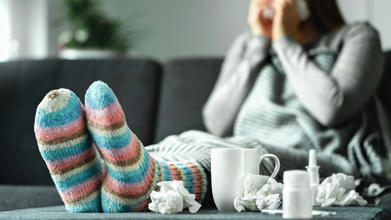- Health Conditions A-Z
- Health & Wellness
- Nutrition
- Fitness
- Health News
- Ayurveda
- Videos
- Medicine A-Z
- Parenting
Alcohol-Free But Not Risk-Free: How ‘Safe’ Non-Alcoholic Drinks Could Be Slowly Damaging Your Liver

Image Credit: Freepik
Timothy had always been health-conscious. After years of social drinking, she decided to quit alcohol for good. But giving up the ritual of sipping on a drink at social gatherings felt impossible. That's when alcohol-free beer and wine seemed like the perfect alternative—offering the taste and experience without the intoxication. However, what Sarah didn't realize was that these supposedly "harmless" drinks might still be affecting her liver in ways she hadn't anticipated.
With a global shift toward healthier choices, the rise of alcohol-free beverages has been fuelled. Do these drinks, however, live up to their promise of being risk-free? New research shows that while they may eliminate the dangers of intoxication, they still pose metabolic and liver-related risks, which calls for moderation in the long run.
What Happens in your Body within 10 Minutes of Drinking Alcohol-Free Beverages?
The first time you take a sip of an alcohol-free beverage, your body responds almost instantly. Anshul Singh, Lead Clinical Nutritionist and Dietetics Department says, "In as little as 10 minutes, your taste buds have picked up on the flavors, and your brain might even get a placebo effect, giving you the sensation that you're about to be drunk. Some alcohol-free drinks have up to 0.5% ABV, which goes into the bloodstream in minute quantities but will probably not affect you in any significant way."
By the 30-minute mark, your body has metabolized the sugars, artificial sweeteners, or additives in the drink. "Some people may experience a mild insulin spike, which can cause temporary energy boosts. Some non-alcoholic drinks also contain fermentation byproducts or botanical extracts that mimic the sedative effects of alcohol, causing slight drowsiness or relaxation," adds Anshul.
After 60 minutes, most of the drink has been metabolized. Although there is no risk of intoxication, repeated consumption can subtly affect metabolism, gut health, and even trigger cravings for alcohol among those in recovery. Those sensitive to sugar, caffeine, or preservatives might experience even more pronounced effects over time.
How Alcohol-Free Drinks Affect Your Gut and Liver Connection
Your liver and gut health are connected, forming what is called the gut-liver axis. Anshul emphasises, "Even though drinks without alcohol seem harmless, they usually contain sugars, artificial sweeteners, and fermentation byproducts that can disturb this delicate balance."
- High sugar content may lead to insulin resistance, inflammation, and fat accumulation in the liver.
- Artificial sweeteners may change the gut microbiota, causing metabolic imbalances.
- Preservatives and artificial flavors can also enhance gut permeability, thus potentially leading to leaky gut syndrome.
Long-term consumption of these drinks may gradually affect digestion, liver detoxification, and overall metabolic health, making moderation necessary.
Do Alcohol-Free Drinks Still Trigger Liver Enzymes?
Even though these nonalcoholic beverages contain virtually insignificant alcohol, the liver processes them as well. "These small concentrations of alcohol-which may go as high as 0.5% ABV-trigger the liver's detoxification pathways but only at much weaker intensities compared to ordinary alcoholic drinks. But the added sugars, artificial sweeteners, and preservatives in the products could pose significant pressure on liver functions over the long term," explains Anshul.
High sugar intake causes insulin resistance, which can lead to the buildup of fat in the liver and increase the risk of developing NAFLD. Some fermentation byproducts in these beverages also trigger oxidative stress, which puts extra pressure on the liver. Though occasional consumption will not pose a significant threat, regular consumption might lead to chronic liver stress and metabolic imbalance.
Do Non-Alcoholic Beverages Affect Liver Detoxification?
Although trace amounts of alcohol exist in alcohol-free beer and wine, the body will still have to metabolize them. The body employs the same enzymatic pathways used for alcoholic beverages but at a much lower intensity. However, the added sugars, preservatives, and fermentation byproducts present their own set of challenges:
- Mild inflammation to the liver due to the additives and byproducts within the drinks.
- Insulin resistance resulting from excessive sugar intake, causing fat accumulation in the liver.
- Detoxification pathways are overburdened, and impairment of liver function occurs gradually.
Alcohol-free drinks do not cause the liver to become overwhelmed as traditional alcohol does, although it does have a lower, but still important, risk for someone who is drinking too much. For someone with a problem of liver disease or metabolic syndrome, limiting alcohol-free drinks is also important.
Should You Drink Alcohol-Free Beverages?
Alcoholic beverages have always been a dangerous drink, but the safer option for those who want to avoid intoxication. However, it is not totally risk-free. Its impact on metabolism, gut health, and liver function cannot be ignored. Although they are not harmful at first, their consumption over a long period leads to insulin resistance, liver stress, and imbalance in the gut.
For the consumers who love these drinks, moderation is the way forward. The expert shares, "The choice of brands with the least additives, lower sugar, and natural ingredients will reduce risks. In addition, supplementing with a diet that is rich in antioxidants, fiber, and hydration can complement the liver in general."
For most, thought that adopting alcohol-free beverages was a healthier decision. On discovering their side effects on liver health, though, she learned to limit its intake and settle for alternatives that included infused sparkling water, herbal teas, or even kombucha with controlled sugar levels.
The bottom line? Alcohol-free doesn't mean consequence-free. The best way to achieve long-term health is by paying attention to what goes into the body and yet still enjoy social rituals of preference.
Anshul Singh is the Team Lead with the Clinical Nutrition and Dietetics Department at Artemis Hospitals in India.
Flu Cases On The Surge, ER Doctor Shares 5 Must-know Things About The Illness

Credits: iStock
Flu cases are on the rise and as of the January 3, 2026 data by the Centers for Disease Control and Prevention, more than 120,000 cases have been detected in clinical laboratories, apart from those detected in home tests. About 40,000 influenza cases were admitted to the hospital in the prior week and 17 influenza-related deaths reported in children, this season. Physicians across the US are constantly telling everyone, especially the vulnerable population to keep an eye on the symptoms. They have time and again also urged people to get vaccinated against the flu. The country is also seeing an overload of flu cases, with many calling it the 'worst flu season' ever.
The 2025-2026 flu season's main culprit is the influenza A (H3N2) subclade K, or the superflu. This variant is a mutated strain of H3N2 virus and has a history of being most contagious, staying longer on surface, which is why it is driving the most numbers of hospitalization this season.
Jesse Pines, Chief of Clinical Innovation for US Acute Care Solutions and a practising physician for over 20 years of experiences writes for Forbes the 5 must-know things about the flu.
5 Must-Know Things About Flu, From An ER Doctor
Identify the Symptoms
It is important to know what symptoms you have to know about the illness. This flu starts with high fever, cough, fatigue, muscle aches, sore throat and a headache. However, not everyone can have the similar symptoms. Children could experience gastrointestinal symptoms, which include nausea, vomiting and diarrhea. Older adults may have atypical symptoms, which may include not feeling hungry, dizziness, or weakness.
Read: Face Masks Are 'Inadequate', Says WHO, Must Be Swapped For Respirators
Vaccine Is A Must
While the flu vaccine for this season was made at least 7 to 8 months before, like usually it happens, which means the subclade K strain may not be this vaccine's target. However, data shows that despite this mismatch, it has a 72 to 75% effective rate in preventing emergency department visits and hospital admissions in children and adolescents, and 32 to 39% effectiveness in adults.
What To Do If You Have Flu Symptoms
The first response should be to contact your healthcare provider for prescription. Pines note that "Oseltamivir (Tamiflu) and baloxavir (Xofluza) are primary options". These are used to reduce the symptom duration, and prevent any further complications like pneumonia. It is most effective if started with in the 48 hours of symptoms.
Should You Seek Higher-Level Medical Care With Flu?
While many people recover at home, if you see your symptoms are not showing any signs of reduction beyond 4 to 5 days, you may need a higher levels of medical care for your flu. This could also be applied if your symptoms worsen suddenly after a few days.
How to Manage Post Flu Weakness?
While everyone is talking about flu and its treatment, not much attention is paid on what to do afterwards. Even after the treatment, one might feel the weakness during their recovery period. This has a scientific name, known as 'post-viral' syndrome, which means a lingering cough and fatigue for 2 to 3 weeks after the illness. This is the time when you gradually return to normal activities, but ensure to maintain adequate hydration, sufficient calorie and protein intake in your diet and adequate sleep.
NHS Warns Of Side Effects Linked To Common Heart Medication Propranolol

Credits: Canva
The NHS has issued an alert for anyone taking a widely used heart medication. People are being advised to watch for serious warning signs, including yellowing of the skin or “nosebleeds lasting more than 10 minutes.”
What Is Propranolol?
Propranolol is a beta blocker that slows the heart rate and relaxes blood vessels, helping lower blood pressure and reduce the heart’s oxygen demand. It is also prescribed to ease symptoms of anxiety, such as trembling or excessive sweating, and can help prevent migraines. The medication is prescription-only but is commonly prescribed throughout the UK.
According to the Mirror, the British Heart Foundation reports that more than 50 million beta blocker prescriptions are issued in the UK each year, including for propranolol. Patients usually take it once a day, in either a standard or slow-release form.
While propranolol is generally safe, it does carry possible side effects. The NHS advises contacting 111 immediately if serious symptoms affecting the blood or kidneys appear.
The NHS notes: “Like all medicines, propranolol can cause side effects in some people, but many experience none or only minor effects. Side effects often ease as your body adjusts to the medication.”
Propranolol Side Effects
Common side effects include headaches, fatigue, weakness, cold fingers or toes, nausea, and stomach discomfort. While most people over 12 can safely take propranolol, the NHS recommends consulting a doctor first if you have a history of low blood pressure, heart failure, depression, or diabetes.
More serious reactions can occur, including yellowing of the eyes or skin, pale stools, or dark urine. The NHS also warns of nosebleeds lasting longer than 10 minutes, unexplained bruising, or increased tendency to bruise easily.
Anyone experiencing these warning signs should contact a doctor or call 111 immediately. The NHS also cautions against stopping propranolol abruptly without medical guidance, as this could trigger severe heart problems, including chest pain or even a heart attack.
Who Should Be Extra Cautious With Propranolol
While propranolol is widely prescribed and generally safe for most adults, certain people need to monitor themselves more closely or consult their doctor before use. Those with low blood pressure, heart failure, slow heart rates, diabetes, respiratory conditions like asthma, or a history of depression may face higher risks of side effects. Pregnant or breastfeeding women should also speak to a healthcare professional before taking the medication.
The NHS emphasizes that even minor symptoms—like unusual fatigue, dizziness, or cold hands and feet—should not be ignored, especially if they worsen over time. Monitoring for these effects early can prevent more serious complications.
Disclaimer: This article is for informational purposes only and is not a substitute for professional medical advice, diagnosis, or treatment. Always consult a qualified healthcare provider before starting, stopping, or changing any medication. If you experience any side effects or unusual symptoms while taking propranolol or any other prescription medicine, seek medical attention immediately.
Death Cap Mushroom Poisoning Claims California Resident’s Life: Symptoms And Risks Explained

Credits: Canva
A California man died last weekend after eating so-called death cap mushrooms, marking the third fatality linked to the toxic fungi in the state since November.
Health officials say California is seeing an unusually high number of mushroom poisonings this season. Between November 18 and January 4, at least 35 cases were reported statewide. In a typical year, the number is usually fewer than five.
“This year’s figures are far beyond what we normally see,” said Sheri Cardo, a communications specialist with the California Department of Public Health.
California Resident Dies After Eating Death Cap Mushrooms
At least three people have now lost their lives in California due to death cap mushroom poisoning since November. Media reports indicate a sharp rise in cases tied to foraged wild mushrooms, with more than 35 poisonings recorded over the past three months.
“The numbers we’re dealing with this year are comparatively off the charts,” Cardo told NBC News.
The most recent death occurred in Sonoma County and was the first fatal wild mushroom poisoning reported there this season, according to county health officials.
Dr. Michael Stacey, interim health officer for Sonoma County, urged residents to avoid eating wild mushrooms unless they are purchased from reliable grocery stores or licensed sellers. He warned that death cap mushrooms can look strikingly similar to safe, edible varieties.
What Is Death Cap Mushroom Poisoning?
Death cap mushrooms, scientifically known as Amanita phalloides, are among the most poisonous mushrooms in the world. They commonly grow beneath oak trees and can be found in parks, gardens, and wooded areas.
Experts say these mushrooms are often mistaken for edible types because of their appearance. Typical features include:
- A smooth cap that may appear whitish, pale yellow, light brown, or green
- White gills underneath the cap
- A white spore print
- A cup-like structure called a volva at the base of the stem
- A ring, known as an annulus, around the stem
Death Cap Mushroom Symptoms
Symptoms usually begin between six and 24 hours after ingestion. Early signs often include stomach pain, nausea, vomiting, and diarrhoea.
In many cases, symptoms ease or disappear after one or two days, which can create a false sense of recovery. By that point, however, the toxins may have already caused severe damage to the liver.
According to experts, the poison responsible, known as amatoxin, can seriously harm the liver, kidneys, and digestive system. Without prompt treatment, the damage can be fatal.
U.S. Poison Centers receive an average of about 52 calls each year related to amatoxin exposure, said Hallen-Adams, though not every case is officially reported.
Is the Risk Easing?
The danger may now be starting to decline in parts of California. Mike McCurdy, president of the Mycological Society of San Francisco, said he has noticed far fewer death cap mushrooms during recent foraging trips.
Earlier this winter, McCurdy said he spotted hundreds of death caps during a two- to three-hour walk in Sonoma County. On a recent outing near Lafayette, California, he found just one. “I think we’re getting close to the end,” he said.
© 2024 Bennett, Coleman & Company Limited

